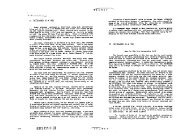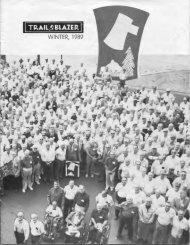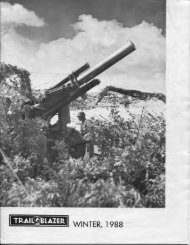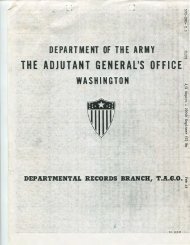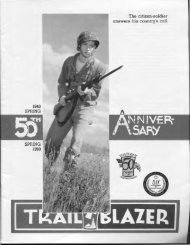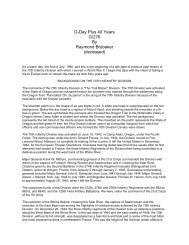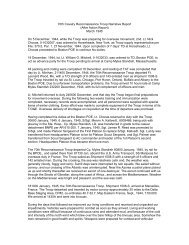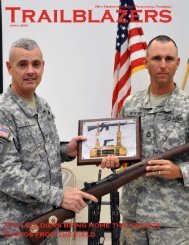Spring, 1987 - 70th Infantry Division Association
Spring, 1987 - 70th Infantry Division Association
Spring, 1987 - 70th Infantry Division Association
- No tags were found...
You also want an ePaper? Increase the reach of your titles
YUMPU automatically turns print PDFs into web optimized ePapers that Google loves.
Counter-attack!<br />
• • • but the <strong>70th</strong> repulses a desperate enemy<br />
By DONALD C. PENCE<br />
This installment is a flash-back to the period which was recounted<br />
in the Fall, 1986 ''Trailblazer." That covered a single day<br />
of combat, February 23, 1945. The <strong>Division</strong> had captured the high,<br />
wooded ground from the Kreutzberg Ridge, below $tiring<br />
Wendel, to the Saar at Buebingen. By sheer numbers, foot soldiers<br />
make up the major portion of an infantry division and <strong>Division</strong><br />
records naturally reflect this. But support units play an essential role,<br />
too, in any infantry victory. So this installment will take a look at<br />
some of the units supporting the <strong>70th</strong>.<br />
The heroic efforts of Feb. 23 are a proud chapter in the Trail-<br />
blazer annals. We overcame the German infantry's stand-or-die<br />
defense supported by lavish use of artillery and armor, including<br />
Mark VI ''Tigers." Too, the enemy defense was aided by the rugged<br />
terrain improved by bunkers, trenches and tank ditches, for our<br />
assault battalions had now entered the outer defenses of the<br />
Siegfried Line. German SS Lt. Gen. Max Simon, after inspecting the<br />
complex around Spicheren Heights in November, 1944, wrote<br />
with apparent grim satisfaction about its excellence as a defensive<br />
position. It was Simon's Xlllth SS Panzer Corps that made the main<br />
effort west of the Bitche during the German Norwind offensive in<br />
January.<br />
HAY ING BEEN FORCED back from<br />
this key defense line on February 23,<br />
the enemy reacted with a series of<br />
violent counterattacks over the next several<br />
days. The German 347th <strong>Division</strong> had borne<br />
the brunt of the recent fighting, and its 36th<br />
<strong>Infantry</strong> on Spicheren Heights was in particularly<br />
bad shape even though it had received<br />
replacements diverted from the <strong>Division</strong>'s<br />
other two regiments, which had been less heavily<br />
engaged. During the period, elements of the<br />
2nd Mountain, 559th Yolks Grenadier and 19th<br />
Yolks Grenadier <strong>Division</strong>s were fed into the<br />
battle to add their weight to the counterblows.<br />
Trailblazer casualties, light during the first<br />
several days of the Saar offensive, but increasing<br />
sharply beginning on February 21, remained<br />
high. The impassive language of the<br />
<strong>Division</strong> Report of Operations for Feb. 24 was<br />
accurate enough in its reflection of units,<br />
events, times and locations. There was no room<br />
in such reports for the human drama attending<br />
these happenings:<br />
"(1) 274th lnf: Co. F, 276th lnf atchd.<br />
Enemy counterattack from NW at 0830 consisting<br />
of infantry only. Enemy in small groups<br />
continued to harass troops in GIFERTW ALD<br />
WOODS. Mop-up of woods continued during<br />
the day. At I 400 enemy counterattack from vic<br />
STIRING-WENDEL; no armor used . Contact<br />
regained with Co. E and enemy driven from<br />
woods. Co. F, 276th Inf. in regimental reserve.<br />
"(2) 275th lnf: Enemy artillery fell in 3rd Bn<br />
area at 1030. lst Bn received small counterattack<br />
consisting of infantry and four tanks . All<br />
attacks repulsed. Positions on <strong>Division</strong> objective<br />
being consolidated and secured.<br />
"(3) 276th lnf (less Co. F): Regiment holding<br />
positions along railroad tracks in FOR<br />
BACH . Continued mopping up and patrolling<br />
Supporting troops<br />
share team victory<br />
10<br />
streets. Cos. E and F relieved by elements of<br />
lst and 3rd Bns. 2nd Bn (-Co. G and Co. F)<br />
assembled in COCHEREN. Harassing enemy<br />
artillery continued throughout the day.''<br />
The 274th's Col. Conley did not take lightly<br />
the counterattack in hi s area. He asked G-3<br />
about getting back his troops tied up in the<br />
Gifertwald in the 275th sector, pointing out that<br />
he didn't have a "damn thing to guard that<br />
hill. " He noted that the enemy was behind his<br />
Co. E and judged that the Kreutzberg Ridge<br />
below Stiring-Wendel could be lost unless he<br />
received additional forces.<br />
That the enemy was taking fearful casualties<br />
in its continuing counterattacks was indicated<br />
in a POW interrogation report obtained the next<br />
day and forwarded by the 274th S-2 to <strong>Division</strong>.<br />
The POW stated that the total strength of<br />
the 1st Battalion, 1126 YG Regiment, 559th<br />
YG <strong>Division</strong> had been reduced to 50-60 men<br />
and that it had 50 KIA 's during the counterattack<br />
of Feb. 24. According to a German unit<br />
history, the 559th had been committed to recapture<br />
the " Spicheren fortifications. " The unit<br />
history noted further that, contrary to the recommendation<br />
of the CG, 347th <strong>Division</strong> (cited<br />
above), the first regiment of the 559th VG to<br />
have arrived in the area was committed immediately<br />
without waiting for the arrival of the<br />
entire division, the result being a piecemeal<br />
attack.<br />
·'Snow, Ridges and * Pillboxes.'' ·'Sometime<br />
during the hours of darkness, the Krauts succeeded<br />
in moving up the draws undetected, and<br />
by daybreak they were ready to charge our<br />
foremost positions. Capt. Sisson's Easy Company<br />
(274th) bore the brunt of the attack. 'The<br />
Krauts were on top of us before we knew what<br />
happened, ' recalls Sgt. Barrett. 'They went<br />
through the gaps in the woods, past the front<br />
line defenses, and headed for the mortar positions<br />
on top of the hill. Fighting raged at close<br />
quarters.' "<br />
Sgt. Edward Kachursky, 274th Co. B., was<br />
hit four times in the German counterattack that<br />
overran his position on Kreutzberg Ridge. Motioned<br />
by his captors to come with them, Kachursky<br />
struggled to his feet, then fell, too weak<br />
to stand. A very young German medic gave him<br />
first aid, and Kachursky gave the boy his watch<br />
and some rations when the others left them<br />
alone. Then armed Germans reappeared, Kachursky<br />
judged, to finish off any wounded<br />
Americans. The young medic covered Kachursky<br />
with a blanket hiding his GI identity.<br />
Kachursky was liberated when the same<br />
ground was retaken by an American counterattack,<br />
during which the young German medic<br />
was killed, his head blown off.<br />
Co. B, 274th was digging in after a tough<br />
day's fighting when the enemy suddenly<br />
counterattacked. Dropping their shovels and<br />
picking up their M-1' s, Sgt. Elmo Chappell and<br />
two of his buddies found the weapons, fouled<br />
with mud, wouldn't fire semi-automatically.<br />
Motioning his buddies to cover where they<br />
could load each round manually, Chappell<br />
took up an exposed position and fired each rifle<br />
as it was loaded and passed to him. He accounted<br />
for eight Germans, and the enemy<br />
attack was turned back.<br />
*<br />
THE GERMAN A IT ACK that hit the I st<br />
Bn, 275th, was not so easily repelled<br />
as the quoted <strong>Division</strong> report of operations<br />
seemed to indicate. It hit at 8:45 a.m.<br />
between Cos. A and C, and a request was made<br />
for tank support. Two of the four enemy tanks<br />
broke through, one through Co. C, which had<br />
been forced back 250 yards. It was not until<br />
12:41 p.m. that the tanks were cleared from the<br />
Co. C area, and from the Co. A area not until<br />
later. Then both units moved up to their earlier<br />
positions. Several friendly tanks which had<br />
bogged down and had been abandoned in the<br />
Pfaffenwald were fo und to have been stripped<br />
by the enemy, gas and oil drained. General<br />
Barnett ordered the 2<strong>70th</strong> Engineers to recover<br />
the tanks, but it was found that the engineers'<br />
winches weren't strong enough for the job. The<br />
<strong>70th</strong> <strong>Division</strong> Assn. TRAILBLAZER



